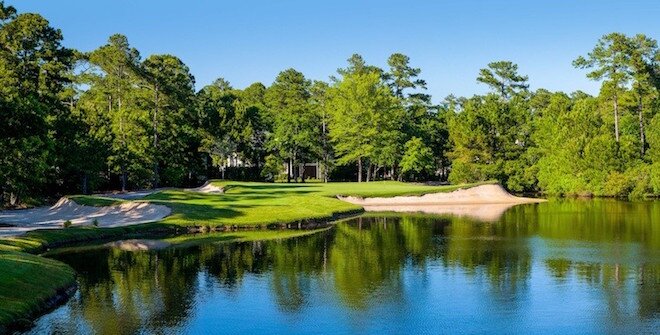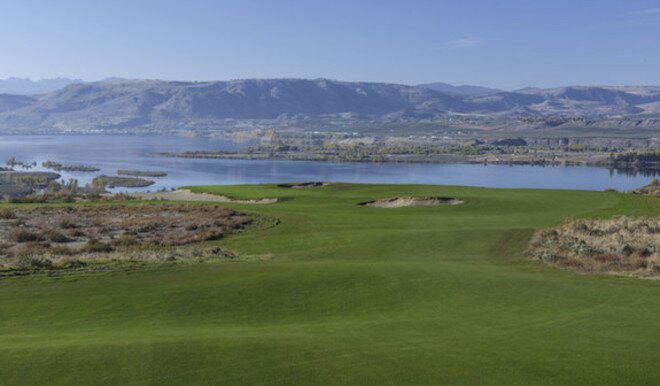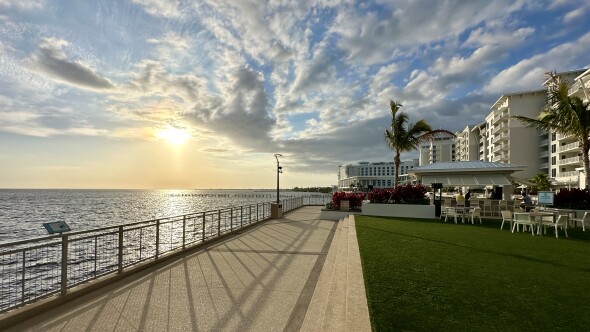Happy Masters Week from all of us at Golf Vacation Insider!
Not only is Augusta National Golf Club one of the world's greatest golf courses, it's also one of its strangest courses.
Yes, I know that's an odd thing to say, but it's a good thing. See, Augusta is different because of something it lacks - or, is supposed to lack:
Long-grass rough.
In fact, the original Augusta National layout had only two cuts of grass: the greens, and everything else at fairway-length.
Yes, they introduced the inch-long "first cut" in 1999, but Augusta National still stands in stark contrast to the majority of U.S. Open and PGA Championship venues, where narrow fairways give way to gnarly, ankle-deep rough. This year's Open and PGA sites, Oakmont and Baltusrol, will punish missed fairways with hack-out rough, no doubt.
This week's field, on the other hand, will instead worry more about which side of the fairway to attack from. Yes, the Green Jackets have added trees in recent years to slim down some corridors, but angles still matter, and always will.
While the chances of playing Augusta National are slim to none, there are many courses that you can play - all over the place - where you'll get a similar experience, based on three key principles:
- Fairways tend to be wide, but you need to play to the correct side in order to leave yourself the best angle into the green.
- If/when you miss greens, you have lots of options for shots you can play: lob, pitch, chip, bump-and-run, putt, etc.
- Lost golf balls and skyrocketing scores are not a huge concern, but going low is a massive undertaking.
The best news? Minimizing rough and expanding fairways is trendy, and there are many not-so-private courses where you can experience this Augusta-inspired philosophy of golf course design.
So if you enjoy watching the pros play Augusta National and want to visit courses where long rough is not a worry, here are our recommendations:
A Pinehurst Trio: Pinehurst No. 2, Mid Pines and Dormie Club

Given that the term for the terrain surrounding Pinehurst is "sandhills," it's no wonder that it is home to a close concentration of courses where long grass is kept to a minimum. But it wasn't always this way, as the Bill Coore/Ben Crenshaw-designed Dormie Club only opened in the last decade and Donald Ross' No. 2 (recent work by Coore/Crenshaw) and Mid Pines (Kyle Frantz) underwent major renovations in the last five years that stripped them of their thick, round-killing Bermuda roughs.
In the 2014 U.S. Open at No. 2, the "rough" provided more uncertainty than brutality, as players were able to advance the ball quite far, but only after taking on some risk. Visitors and Pinehurst-area residents laud Dormie and Mid-Pines for the same sort of off-fairway sandy scrub.
True Blue Golf Club - Pawleys Island, South Carolina

True Blue opened in 1998, designed by the late Mike Strantz, who took inspiration from Pinehurst and another course without much "traditional" rough - Pine Valley in New Jersey - in crafting this design about a half hour south of Myrtle Beach. Its fairways are more than 80 yards wide in places, meaning that hitting every fairway on the golf course is an attainable feat, but getting the best angle into every green can be surprisingly tricky.
Poppy Hills Golf Course - Pebble Beach, California

To the untrained eye, the "old" Poppy Hills actually looked more like Augusta prior to its recent overhaul by Robert Trent Jones II. But there's no doubt that its wider fairways now give the marginal player more hope than before. And since risk and reward are part of why the back nine at Augusta National is so thrilling, any course that embraces that dramatic tension becomes more like this week's venue.
Tiburon Resort (Gold and Black Courses) - Naples, Florida

One of the more fascinating facts of modern golf course design is that Greg Norman, who suffered as much heartbreak at the Masters as any player who never donned a Green Jacket, tends to make his courses look like Augusta National. The 36-hole complex he laid out at Tiburon may not have Augusta's elevation changes, but its no-rough philosophy, paired with the presence of pine straw off most fairways, makes the comparison obvious.
Streamsong Resort (Blue and Red Courses) - Streamsong, Florida

Streamsong's terrain is alien and unique to the state of Florida, with the site for its two (and soon a third) golf courses consisting of pure sand. So naturally, long rough was not a consideration for Tom Doak, who designed its Blue course, or Coore & Crenshaw, who fashioned the Red. Like at True Blue, you can stray 30 yards from the center and still wind up in the fairway, but you may be blocked by obstacles like clever mounding or huge blowout bunkers that will keep you from making birdies. Or you can discover shortcuts that put you in prime position. Learning to play a course properly is half the fun at Augusta, and it's a reason why Streamsong visitors love to return.
Gamble Sands Golf Course - Brewster, Washington

David McLay Kidd designed the original Bandon Dunes Course, but then somewhat lost the plot of top-quality golf course design, according to some, as his subsequent layouts tended to levy extreme punishments for mediocre shots. He had an epiphany along the way, though, and Gamble Sands, despite its remote location in eastern Washington, is becoming known for its sense of adventure, accentuated by Kidd's liberal use of fairway-length chipping areas around the greens. This allows golfers to play to their strengths in pursuit of a cherished up-and-down, which calls to mind the short-game creativity that Masters champions like Tiger Woods and Phil Mickelson have exhibited in their own victories.
What are your favorite no-rough (or almost-no-rough) golf courses? Be sure to share your own recommendations below!












I like going to the driving range, but I really hate playing golf courses. I'm not good enough to keep the ball inbounds most of the time.
I was daydreaming of a golf course where:
1) There's no rough, no trees and no hazards of any kind
2) It's all fairway and greens
3) Every fairway is wide enough for even the wildest shots to stay on the hole's fairway
or
4) If a hole isn't wide enough to keep the wildest shots in-play, put up huge walls on each side made of a soft, rubbery substance that you can bounce balls off of
I think this sort of course would actually be fun for someone like me. I don't have much fun playing regular golf courses.
Golf Central Alberta in Red Deer,Canada.
A couple of golf courses come to mind, Pine Dunes and Links at Lands End in east Texas. I like both, but for beautiful scenery and a great course, you can't beat Links at Lands End, a hidden gem on Lake Fork, one of the best bass fisheries in North America. Water, but no rough and player friendly. Highly recommend it.
Player friendly is the reason golf is losing it's popularity. Golf is supposed to be a challenge for players of all levels. If you cut the rough down and widen the fairways, the essence of the game is lost to commercialism. Go to a driving range if you want player friendliness, but stop ruining the game in the name of fast play. And while we are on the subject, enough of ready golf. Tradition is also being killed in the name of money.
Marc--
I think you're conflating "player-friendly" with "non-challenging" here. I don't think anyone would really argue that any of the courses mentioned in this article are out-and-out pushovers.
Also, re: the "essence of the game," I think in doing some research into the history of golf course design, you would very quickly find that the courses of yesteryear were wider off the tee and did not lean nearly as much on long rough as courses built in the second half of the 20th century tended to. In fact, these courses that are increasing the width of their fairways and prompting golfers to use angles to tack their way around successfully are the courses that are acting in a more traditional manner. By contrast, the courses that continue with narrow fairways bordered by thick rough are in fact the historical interlopers.
--Tim
No golf course is a pushover for a golfer lacking skills, however, the challenge of overcoming obstacles and rewards for a good shot, are the essence of what made the game great. User friendly, wide fairways, and short rough do not make the game more fun for those of us who have spent years working on improving our games. I was a zero handicap player for years, however, I never hit the ball long, but I was down the middle on most of my shots. This allowed me to compete with players who hit the ball well past me. Do you believe the higher handicap members of courses, such as Augusta National, prefer sand traps to be removed, have their fairways wider etc.? I doubt it. I understand that you have a modern day view of golf that is centered on player friendliness, ie commercialism, but, bear in mind that you are contributing to the destruction of the game.
You, obviously, have proven to any reader that you associate yourself with the lowest common denominator of golfers, You side with present day management that believes they will increase profits by speeding up play and making courses less challenging. I have played golf all over the world for over fifty years. When I refer to the elements that make up a great course, I am making reference to what makes a course great today, as well as years ago. You make reference to a broad, generalized view of course design that appeals to the average player. Your attitude is a contributing factor as to why golf is losing it's appeal. I grew up in an era when gas stations had attendants and stores offered more service. You, apparently, have not experienced this, which explains why you defend lowest common denominator golf. Labeling courses with narrow fairways and thick rough as historical interlopers tells me you have substituted ease of play for quality. Golf will continue to lose if it loses the foundation that made it great.
Marc--
I would venture to say that my palate for golf courses is broader than most. Have you played any of the courses listed in this article? What kind of scores have you shot there? I guess if you've averaged 65 or lower in your rounds at True Blue or Streamsong, I could see why you'd think they're pushovers. Bully for you.
But your claim that these courses represent "lowest common denominator golf" is miles off-base.
--Tim
You completely miss my point. I am not criticizing these particular courses. I am against the concept of player friendly. I take your word that these courses are challenging to golfers of all levels, but I resent wide fairways and rough that does not create a challenge. These courses, themselves, are not the lowest common denominator, but the appeal that you represent is to the lowest common denominator player. Do you see the difference?
So on one hand, you concede that these courses are "challenging to golfers of all levels.
On the other hand, you "resent wide fairways and rough that does not create a challenge."
Both of these statements cannot be simultaneously true.
You are 100% incorrect that promoting these courses as good is an appeal to the lowest common denominator of golfers, and here's why:
Hitting a ball off fairway-length grass does not mean a shot is not challenging. On courses with wide fairways, where it's better to be on one side than the other, a shot from a particular side of a fairway can be plenty challenging, especially if you're having to hit over a corner of a bunker that would not be in the way from the other side.
This sort of strategic design is a challenge not just from the "lowest common denominator" player whom you seem to disdain, but for players of all handicap levels. I'm a scratch player who won a couple tournaments in college and a couple others since, and I can tell you with no doubt whatsoever that there are plenty of courses with wide fairways that are very challenging. So to hear you state categorically that courses with wide fairways and little rough "do not create a challenge" is completely disagreeable. I would encourage you to be more open-minded about the sorts of challenges golf courses can present before you seriously accuse anyone of "contributing to the destruction of the game."
Finally, here's a list of noteworthy courses I've played that you would probably dismiss for having wide fairways, but where you would struggle to play to your handicap:
- True Blue
- Tobacco Road
- Pinehurst No. 2
- Ballyhack
- Sand Valley
- Streamsong Blue
- Quail Valley
- PGA Golf Club (Dye)
- Sea Island (Seaside)
- Fort Myers Country Club
In conclusion, fairway width is a ridiculous reason to claim a golf course is not good or not challenging. That attitude is a much bigger threat to golf than my own.
So on one hand, you concede that these courses are "challenging to golfers of all levels.
On the other hand, you "resent wide fairways and rough that does not create a challenge."
Both of these statements cannot be simultaneously true.
You are 100% incorrect that promoting these courses as good is an appeal to the lowest common denominator of golfers, and here's why:
Hitting a ball off fairway-length grass does not mean a shot is not challenging. On courses with wide fairways, where it's better to be on one side than the other, a shot from a particular side of a fairway can be plenty challenging, especially if you're having to hit over a corner of a bunker that would not be in the way from the other side.
This sort of strategic design is a challenge not just from the "lowest common denominator" player whom you seem to disdain, but for players of all handicap levels. I'm a scratch player who won a couple tournaments in college and a couple others since, and I can tell you with no doubt whatsoever that there are plenty of courses with wide fairways that are very challenging. So to hear you state categorically that courses with wide fairways and little rough "do not create a challenge" is completely disagreeable. I would encourage you to be more open-minded about the sorts of challenges golf courses can present before you seriously accuse anyone of "contributing to the destruction of the game."
Finally, here's a list of noteworthy courses I've played that you would probably dismiss for having wide fairways, but where you would struggle to play to your handicap:
- True Blue
- Tobacco Road
- Pinehurst No. 2
- Ballyhack
- Sand Valley
- Streamsong Blue
- Quail Valley
- PGA Golf Club (Dye)
- Sea Island (Seaside)
- Fort Myers Country Club
In conclusion, fairway width is a ridiculous reason to claim a golf course is not good or not challenging. That attitude is a much bigger threat to golf than my own.
You miss my point again. I do not want to attack you personally, but you do lack critical analysis skills. A golf course that has one hundred yard wide fairways, no rough, no bunkers, no water, no trees, is CHALLENGING TO ANY PLAYER because that player still has to hit the ball straight, land his shots near or on the greens, and putt. My point, once again, is STOP APPEALING TO THE LOWEST COMMON DENOMINATOR OF GOLFERS BY WIDENING FAIRWAYS AND REMOVING THE CHALLENGE. You attempt to defend this ideology by naming the courses, in which you write about. I am not saying these are not good courses. I am saying that I resent the appeal to fast play and commercialism that seems to be the goal of management today. You are missing my point by trying to defend these courses. I am not saying they are not enjoyable to play. I want tradition returned to the game. I realize the only way to find this is to be a member of a private club that caters to this. By the way, I also resent the use of golf carts instead of walking. Most courses today that are open to the public do not have caddies.
I’m on Tim’s side here. He makes good points and when Marc disagrees he says he “lacks critical analysis skills.” Touché old man.
Marc, I'm not missing your point. It's just that your point is invalid, because a) wide, angle-encouraging fairways *do* "return tradition to the game," and b) emphatically do not appeal to the lowest common denominator of golfer because they appeal to *alll* golfers.
For what it's worth, I'm afraid it's going to be increasingly difficult to find the one-dimensional, boring private course you thirst for, because private clubs are rapidly learning that bowling-alley-surrounded-by-hay setups are neither traditional nor much fun for the vast majority of the millions of golfers out there who enjoy the game.
I don't know what more evidence I can provide at this point as to why your point is invalid, so I'll bow out here. Hit 'em straight!
Sweetens Cove in South Pittsburg, TN. Best course in the state & best nine hole in the nation! It's fairway cut everywhere & has one of the best sets of greens anywhere in the world.
Maybe an article about some nice and reasonablyou priced golf courses .
Cascata in Henderson,NV.